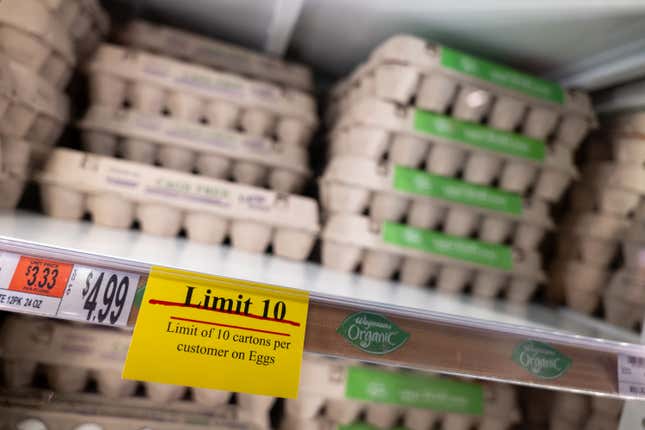
In This Story
After hitting a record high this year, egg prices are set to rise even further.
The U.S. Department of Agriculture said in a report on Tuesday that it projects that prices will rise 41.1% this year. Just last month, the USDA predicted only a 20% increase.
The rising cost is due to two main factors: steady inflation and a surge in bird flu cases affecting egg-laying hens nationwide. This has led to shortages in grocery stores, with some, including Trader Joe’s, limiting how many cartons customers can purchase.
The USDA said combined retail egg prices surged 13.8% in January after an 8.4% rise in December. The price of a dozen large grade A eggs reached a record $4.95 in January, up over 96% from just $2.52 a year ago, according to data released earlier this month by the Bureau of Labor Statistics.
Here is everything you need to know about rising egg prices:
How is a spike in bird flu infections affecting egg prices?
The primary cause is the shrinking of the nation’s egg-laying hen population due to the ongoing bird flu outbreak.
H5N1 is a strain of bird influenza that was first detected in 1996 in domestic water foul — such as ducks and geese — in Southern China. It is highly-contagious among birds. A new outbreak was first detected in 2020 among wild birds in Europe, which made its way to the U.S. in 2022.
Since then, more than 166 million birds, including commercial poultry, have been infected, according to the U.S. Centers for Disease Control and Prevention (CDC). In just the past 30 days, almost 18.9 million cases among U.S. birds were detected.
Whenever a flock is infected it is culled — killed — to stop the spread of the virus. For example, a farm in New York recently made headlines after it was forced to euthanize 100,000 ducks after health officials confirmed the flock was infected with the bird flu.
The U.S. Department of Agriculture (USDA) reported this month that the country’s egg production fell 4% in January and the population of all egg-laying poultry fell 5% from last year.
Inflation isn’t helping either
At the same time, overall food prices are on the rise too. The USDA expects prices for all food products to rise 3.4% this year. Grocery store prices are expected to increase by 3.3%.
What is the government is doing to help lower prices?
The Trump administration announced today a five-point plan to “make eggs affordable again.”
U.S. Agriculture Secretary Brooke L. Rollins announced the initiative Wednesday in an op-ed for The Wall Street Journal, disclosing that her department will invest up to $1 billion to help bring prices down.
The plan includes spending on biosecurity measures, on financial relief for farmers affected by the outbreak, and on developing vaccines and treatments against for chickens. Additionally, the administration may roll back regulations to save costs and temporarily allow egg imports to boost supply.
President Donald Trump has also made some efforts at tackling overall rising prices. In an executive order, Trump ordered government agencies to start “pursuing appropriate actions” to lower costs for American families.
He also signed executive orders aimed at increasing oil production and lowering energy costs with the hopes to bring down the cost of all goods.
“Prices are going to come down, but it’s going to take a little bit of time, right?,” Vice President J.D. Vance told CBS’s Face the Nation in January. “Donald Trump has already taken multiple executive actions that are going to lower energy prices, and I do believe that means consumers are going to see lower prices at the pump and at the grocery store.”
When will egg prices start dropping?
It doesn’t look like egg prices will drop soon: The spread of the flu would need to stop first and then it would then take months for farms to replenish their egg-laying hen numbers.
Brian Moscogiuri, a vice president of Eggs Unlimited – a California-based wholesaler, told the New York Times it could take the market six months to stabilize.
“We need to see outbreaks of avian influenza stop,” Moscogiuri said, as cited by the newspaper. “We need a period of time when the farms aren’t being impacted and can repopulate their chickens and we need to see demand start to slow down.”
Rollins wrote in her op-ed that that the administration’s plan could “restore stability to the egg market over the next three to six months.”